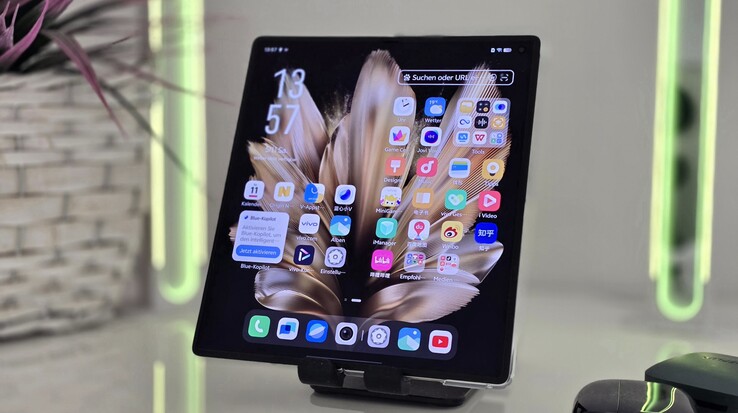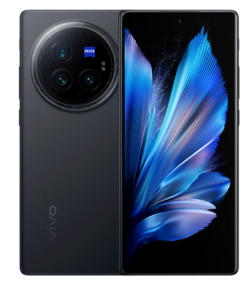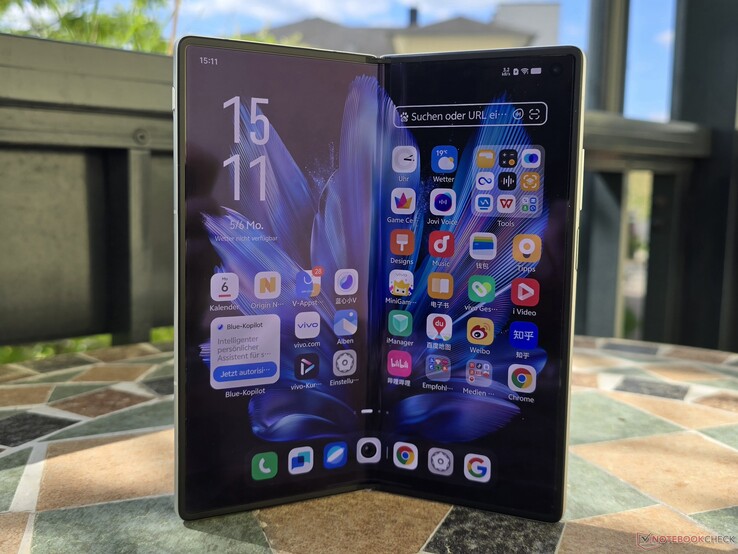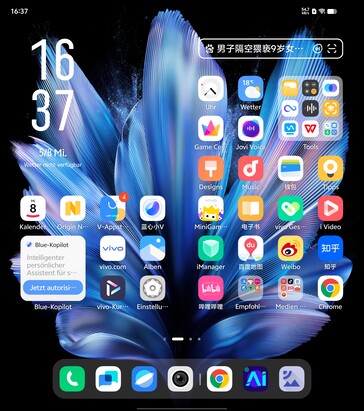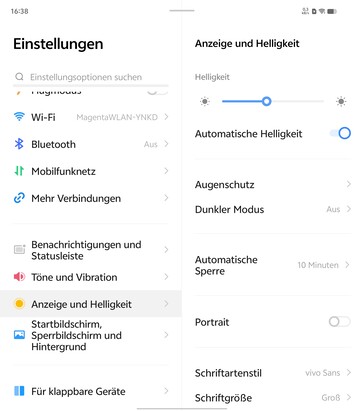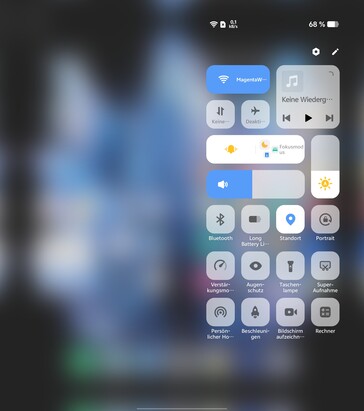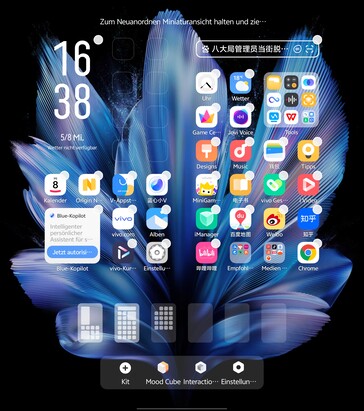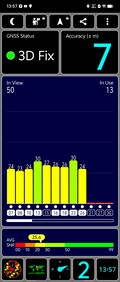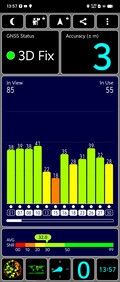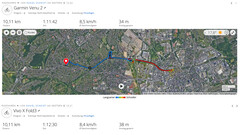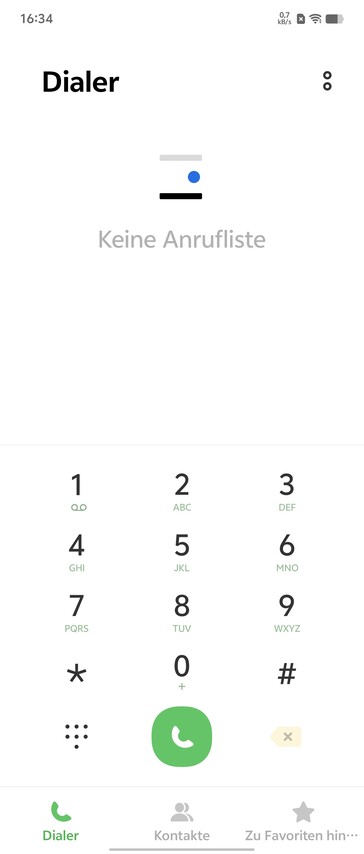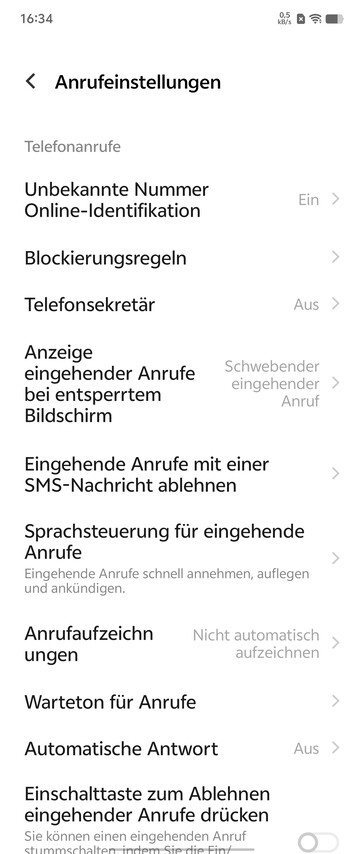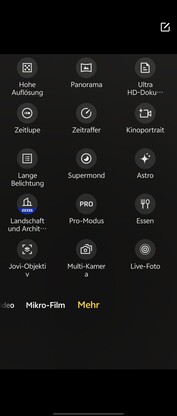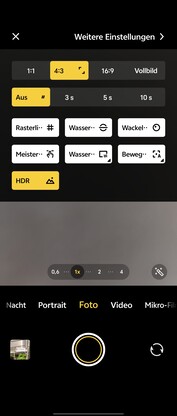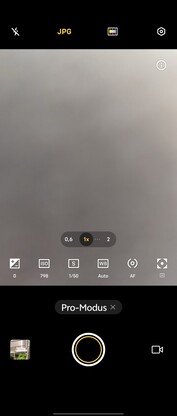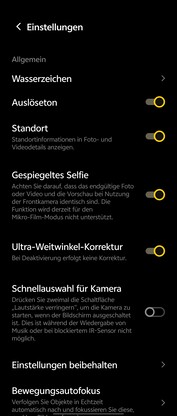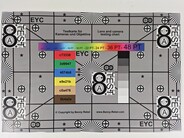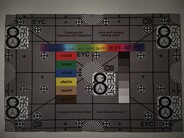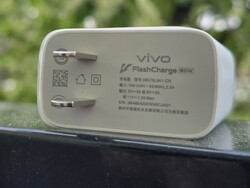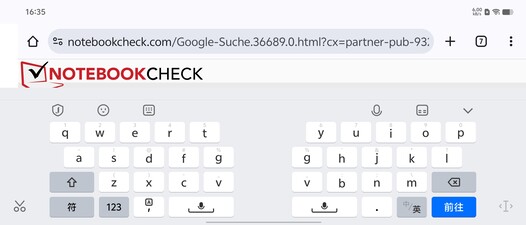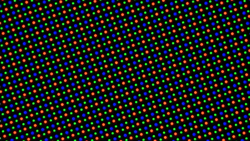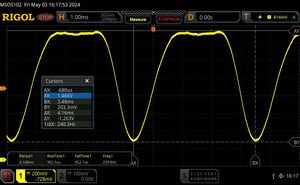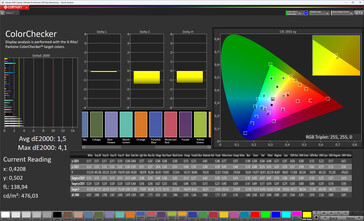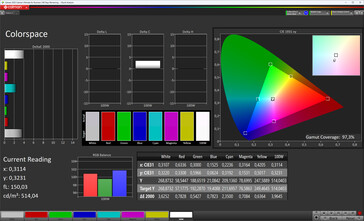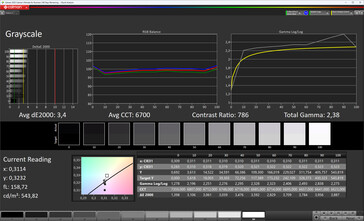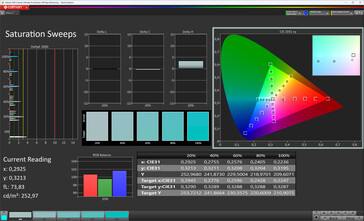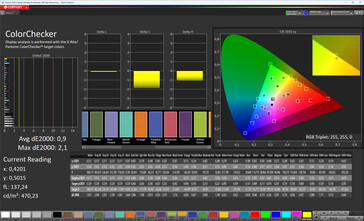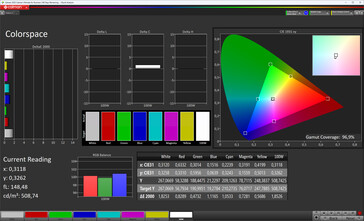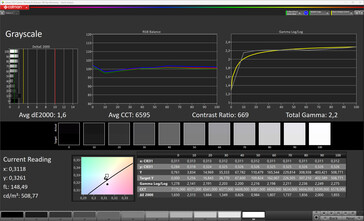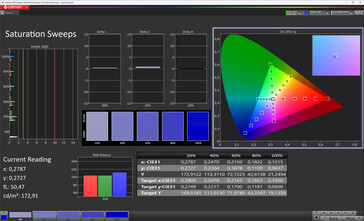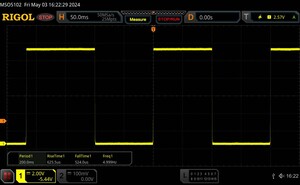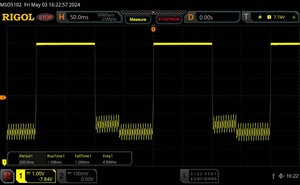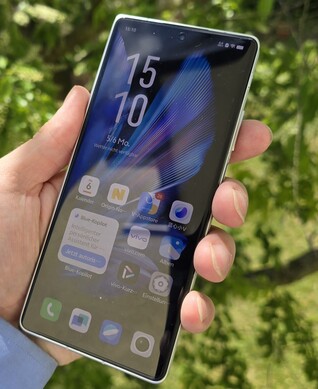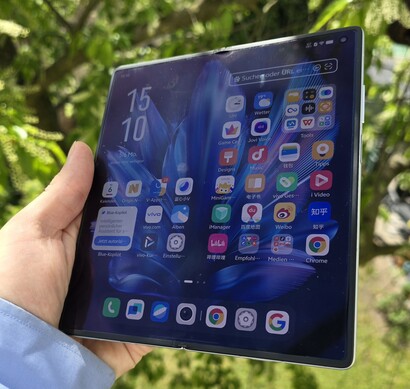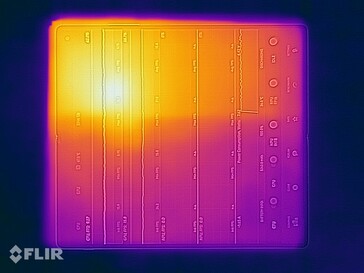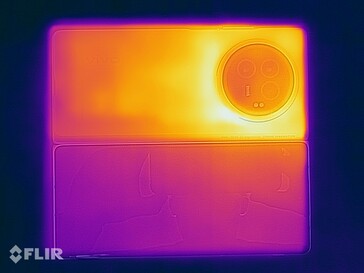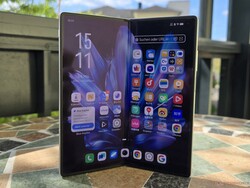Vivo X Fold3 Smartphone Review: A physics-defying, insanely light 8-inch foldable
The Vivo X Fold3 is among the thinnest and lightest foldables on the market. This successor to the X Fold2 weighs 61 g less than its predecessor, but interestingly features a significantly larger 5,500 mAh battery. Although Vivo cannot outwit the limits of physics, this is still an astonishing development in just one year.
The X Fold3 is based on the Snapdragon 8 Gen 2 — the latest Snapdragon 8 Gen 3 SoC is only used in the Pro model of the foldable series. As an import, the Vivo X Fold3 (RRP: from ¥6,999 or ~€700) starts at €1,150 from our rental provider for the version with 16 GB RAM and 256 GB storage.
Vivo has not yet commented on a global launch of the X Fold3 series, but it is rumored that the foldables will eventually find their way to Europe.
Possible competitors in comparison
Rating | Date | Model | Weight | Drive | Size | Resolution | Price |
|---|---|---|---|---|---|---|---|
| 88.8 % v7 (old) | 05 / 2024 | Vivo X Fold3 SD 8 Gen 2, Adreno 740 | 219 g | 1 TB UFS 4.0 Flash | 8.03" | 2480x2200 | |
| 89.1 % v7 (old) | 08 / 2023 | Samsung Galaxy Z Fold5 SD 8 Gen 2 for Galaxy, Adreno 740 | 253 g | 256 GB UFS 4.0 Flash | 7.60" | 2176x1812 | |
| 89 % v7 (old) | 02 / 2024 | Honor Magic V2 SD 8 Gen 2, Adreno 740 | 231 g | 512 GB UFS 4.0 Flash | 7.92" | 2344x2156 | |
| 87.3 % v7 (old) | 11 / 2023 | Xiaomi Mix Fold 3 SD 8 Gen 2, Adreno 740 | 259 g | 512 GB UFS 4.0 Flash | 8.03" | 2160x1916 | |
| 84.7 % v7 (old) | 08 / 2023 | Google Pixel Fold Tensor G2, Mali-G710 MP7 | 283 g | 256 GB UFS 3.1 Flash | 7.60" | 2208x1840 |
Case - Vivo X Fold3 is very light
Tipping the scales at just 219 g, the X Fold3 feel very light for an 8.03-inch foldable smartphone and is quite thin at less than 4.7 mm. A Galaxy Z Fold5 for example, weighs 34 g more and has a 1,100 mAh smaller battery.
However, Vivo's weight specification does not include the inner and outer screen protectors of the X Fold3 — those add up to 225 g. Since it is not recommended to remove the factory-applied protective film to the inner screen, the 219 g spec is more of a theoretical nature.
The build quality is first-class, but the foldable could use a more premium feel in-hand as the back feels like cheap plastic and can be pressed in slightly. Thanks to the narrow edges around the outer OLED panel, the 85.3% screen-to-body ratio is quite amenable for a foldable.
Inside the X Fold3, the screen-to-body ratio is higher at 90.5%. There is no official IP certification. A dedicated button for the sound and silent profiles (mute slider) is present.
Features: X Fold3 with UFS 4.0
The Vivo X Fold3 is available in four different SKUs (12 GB to 16 GB RAM, 256 GB to 1 TB UFS 4.0 memory). In addition to Bluetooth 5.3, an IR blaster, NFC, Miracast, and USB OTG are included. Data transfer via the USB interface is based on the 3.2 Gen 2 standard, which also enables image transfer.
We were unable to determine the exact transfer speed via the USB port in the test, as our external hard disk could not be operated due to the restrictive energy management. The exFAT and NTFS filesystems that are used by Microsoft Windows are supported.
Software: Vivo X Fold3 with Android 14
The X Fold3 presented for China uses the company's own Origin OS 4, which is based on Android 14 and supports a variety of languages including German. Exactly how long Vivo intends to support its premium foldables with OTA updates is not yet clear. Presumably it is within the scope of the X100 Pro, which is slated to receive three major Android versions and three years of security patches. At the time of our test, the security patches were dated March 2024.
Should a global version also follow for Europe, it will not be delivered with Origin OS 4, but with Funtouch OS 14. The latter does not look as modern, but unlike the Chinese version, no Chinese apps and services are pre-installed and Google applications can be used ex-works.
However, Google apps can also be obtained with Origin OS via the in-house V Appstore, and Google Play Store can be subsequently installed and used without any problems. A major advantage with the China version is that updates are rolled out more quickly.
Communication and GNSS: X Fold3 supports 5G
To connect to the mobile data network, the X Fold3 can rely on quite a broad coverage for both 5G and 4G frequencies. The phone provides access to a total of 17 5G and 22 LTE bands. All 4G frequencies relevant for German-speaking countries are covered in the China version, and band 20 and band 28 are also on board. This means that nothing stands in the way of a potential import for network-related reasons.
The foldable has modern Wi-Fi 7 available for WLAN connections. With our reference router Asus ROG Rapture GT-AXE11000, transfer rates of around 1,000 MBit/s on average in the 5 GHz range are possible. However, the X Fold 3 does not support a connection in the 6 GHz channel, so the values are lower than those of the Wi-Fi 6E competition.
| Networking | |
| Vivo X Fold3 | |
| iperf3 receive AXE11000 | |
| iperf3 transmit AXE11000 | |
| Samsung Galaxy Z Fold5 | |
| iperf3 receive AXE11000 | |
| iperf3 transmit AXE11000 | |
| iperf3 transmit AXE11000 6GHz | |
| iperf3 receive AXE11000 6GHz | |
| Honor Magic V2 | |
| iperf3 receive AXE11000 | |
| iperf3 transmit AXE11000 | |
| Xiaomi Mix Fold 3 | |
| iperf3 receive AXE11000 | |
| iperf3 transmit AXE11000 | |
| iperf3 transmit AXE11000 6GHz | |
| iperf3 receive AXE11000 6GHz | |
| Google Pixel Fold | |
| iperf3 receive AXE11000 | |
| iperf3 transmit AXE11000 | |
| iperf3 transmit AXE11000 6GHz | |
| iperf3 receive AXE11000 6GHz | |
| Average of class Smartphone | |
| iperf3 receive AXE11000 | |
| iperf3 transmit AXE11000 | |
| iperf3 transmit AXE11000 6GHz | |
| iperf3 receive AXE11000 6GHz | |
The X Fold3 can use global satellite networks in dual band to determine its position. On a bike ride, we took a look at the positioning qualities in comparison to a Garmin Venu 2. Although the total distance determined by us on the Vivo Phone is identical to the Garmin Watch, minor inaccuracies can be seen in the detailed route.
The Venu 2 is more precise overall, although the Vivo X Fold3 can be used for navigation tasks without hesitation.
Phone functions and voice quality: X Fold3 with Wi-Fi calling
Cameras: X Fold3 with a triple-50 MP setup
As you would expect from a foldable, the X Fold3 has a front and an internal camera. Both have a resolution of 32 MP and offer an f/2.4 aperture. The results are well-balanced and are quite respectable — the exposure with the two lenses looks perfect even in sunshine.
If you can accommodate, you can also use the rear camera module and the front panel as a viewfinder when the foldable is opened to get the best possible selfies.
Specifically, you can choose from among three 50 MP cameras, which have been optimized in collaboration with Zeiss. The main camera is based on the Sony IMX920 and features OIS. It impresses with a harmonious dynamic range and satisfactory sharpness.
We also find the color reproduction of the X Fold3 to be very good, even if green tones can get somewhat distorted. The appealing low-light performance in particular should be emphasized for a foldable smartphone.
The quality of the other two 50 MP lenses is visibly inferior. The telephoto camera is somewhat disappointing; we would have liked to see a little more detail at zoom levels above twice the lossless magnification.
Image comparison
Choose a scene and navigate within the first image. One click changes the position on touchscreens. One click on the zoomed-in image opens the original in a new window. The first image shows the scaled photograph of the test device.
WeitwinkelWeitwinkelLow LightUltraweitwinkelZoom 5x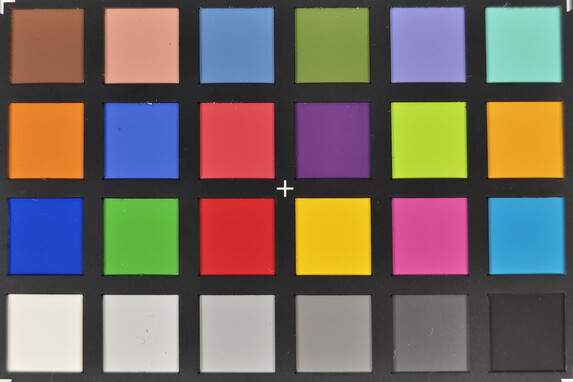
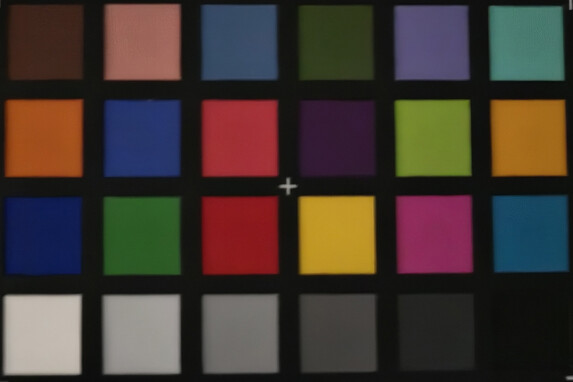
Accessories and Warranty: Vivo X Fold3 comes with a power adapter
The scope of delivery includes a USB cable, a high-quality protective cover with a vegan leather look, and a modular 80 W power adapter with a type A plug. TradingShenzhen also includes an EU adapter for the sockets used in this region, but this is not part of the standard scope of delivery rather is a service provided by the rental company.
Vivo offers a 12-month guarantee period. In the case of our test device from TradingShenzhen, it is also possible to send the X Fold3 to a German shipping address in the event of a warranty claim.
However, Vivo Europe has confirmed to us in the past that warranty claims for models purchased abroad can also be processed in Germany if the devices are officially sold in Europe.
Input devices and operation: X Fold3 supports Face Unlock
The capacitive touchscreens respond quickly, and a protective film is applied to both screens ex-works. This should not be removed from the 8.03-inch internal screen, so you never get the feeling that you are using a glass surface. Animations and scrolling are displayed smoothly thanks to the 120 Hz panels.
Samsung's Flex mode that provides an extended screen option when partially folded, is also supported by the X Fold3 and the hinge design is quite stable. A small, linear electric motor (x-axis) is responsible for vibrations. This provides crisp haptic feedback.
Biometric security is ensured by a face unlock function via the two 32 MP cameras using 2D technology or a fingerprint sensor in the on/off button. The sensor works very reliably and unlocks the Vivo foldable very quickly.
Display: Vivo X Fold3 without the annoying crease
As a classic foldable smartphone, there are two displays that can shine really bright. The flexible AMOLED panel inside measures 8.03 inches in a 4:3.55 aspect ratio. Vivo has managed to ensure that the display crease in the center of the screen is hardly noticeable in everyday life and only really becomes apparent in reflections.
In our measurement, the X Fold3 achieves a peak brightness of 2,589 cd/m² (APL 18). If you watch an HDR-supported video on the 8.03-inch display, you benefit from a luminance of 4,757 cd/m².
The external display in 21.1:9 format measures 6.53 inches and is not quite as bright as the internal one. The taller external display nevertheless achieved a very good 2,322 cd/m² (APL 18) and 3,322 cd/m² (video content) in the test.
Due to the OLED technology of the screens, the Vivo smartphone is not spared from flickering due to PWM. While the outer panel operates at a constant 120 Hz, the PWM frequency of the 8.03-inch display increases with increasing brightness — we measured between 240 Hz and 480 Hz.
According to the manufacturer, however, the X Fold3 uses high-frequency PWM dimming (inner display: 1,920 Hz, outer display: 2,160 Hz). The lower basic flickering that we measured could also be BFI (Black Frame Insertion).
| |||||||||||||||||||||||||
Brightness Distribution: 99 %
Center on Battery: 1793 cd/m²
Contrast: ∞:1 (Black: 0 cd/m²)
ΔE ColorChecker Calman: 0.9 | ∀{0.5-29.43 Ø4.83}
ΔE Greyscale Calman: 1.6 | ∀{0.09-98 Ø5.1}
96.9% sRGB (Calman 2D)
Gamma: 2.2
CCT: 6595 K
| Vivo X Fold3 AMOLED, 2480x2200, 8" | Vivo X Fold3 2748x1172, 6.5" | Samsung Galaxy Z Fold5 Dynamic AMOLED, 2176x1812, 7.6" | Honor Magic V2 OLED, 2344x2156, 7.9" | Xiaomi Mix Fold 3 AMOLED, 2160x1916, 8" | Google Pixel Fold OLED, 2208x1840, 7.6" | |
|---|---|---|---|---|---|---|
| Screen | -51% | -85% | -5% | -7% | -39% | |
| Brightness middle | 1793 | 1580 -12% | 1104 -38% | 961 -46% | 1307 -27% | 993 -45% |
| Brightness | 1806 | 1585 -12% | 1107 -39% | 950 -47% | 1308 -28% | 997 -45% |
| Brightness Distribution | 99 | 94 -5% | 97 -2% | 97 -2% | 96 -3% | 94 -5% |
| Black Level * | ||||||
| Colorchecker dE 2000 * | 0.9 | 1.5 -67% | 3.1 -244% | 0.8 11% | 1 -11% | 1.4 -56% |
| Colorchecker dE 2000 max. * | 2.1 | 4.1 -95% | 4.2 -100% | 1.5 29% | 1.7 19% | 3.2 -52% |
| Greyscale dE 2000 * | 1.6 | 3.4 -113% | 3 -88% | 1.2 25% | 1.5 6% | 2.1 -31% |
| Gamma | 2.2 100% | 2.38 92% | 2.01 109% | 2.23 99% | 2.24 98% | 2.24 98% |
| CCT | 6595 99% | 6700 97% | 6594 99% | 6396 102% | 6313 103% | 6796 96% |
* ... smaller is better
Screen Flickering / PWM (Pulse-Width Modulation)
| Screen flickering / PWM detected | 240 Hz Amplitude: 50.96 % | ||
The display backlight flickers at 240 Hz (worst case, e.g., utilizing PWM) . The frequency of 240 Hz is relatively low, so sensitive users will likely notice flickering and experience eyestrain at the stated brightness setting and below. In comparison: 53 % of all tested devices do not use PWM to dim the display. If PWM was detected, an average of 8327 (minimum: 5 - maximum: 343500) Hz was measured. | |||
Measurement series with fixed zoom level and different brightness settings (foldable display; Info: The amplitude curve at minimum brightness looks flat, but this is due to the scaling. The info box shows the enlarged version of the amplitude at minimum brightness)
Measurement series with fixed zoom level and different brightness settings (outer display; Info: The amplitude curve at minimum brightness looks flat, but this is due to the scaling. The info box shows the enlarged version of the amplitude at minimum brightness)
We examine the color calibration of the OLED panel using the Calman Ultimate analysis software from Portrait Displays. In the "Professional" profile and the "Standard" white balance, the sRGB color space is controlled and largely covered.
Our measurement with the X-Rite spectrophotometer results in very low average delta E deviations of 0.9 (ColorChecker) and 1.8 (Grayscale) for the internal display.
Display Response Times
| ↔ Response Time Black to White | ||
|---|---|---|
| 1.15 ms ... rise ↗ and fall ↘ combined | ↗ 0.6255 ms rise | |
| ↘ 0.524 ms fall | ||
| The screen shows very fast response rates in our tests and should be very well suited for fast-paced gaming. In comparison, all tested devices range from 0.1 (minimum) to 240 (maximum) ms. » 4 % of all devices are better. This means that the measured response time is better than the average of all tested devices (20.5 ms). | ||
| ↔ Response Time 50% Grey to 80% Grey | ||
| 2.69 ms ... rise ↗ and fall ↘ combined | ↗ 1.398 ms rise | |
| ↘ 1.289 ms fall | ||
| The screen shows very fast response rates in our tests and should be very well suited for fast-paced gaming. In comparison, all tested devices range from 0.165 (minimum) to 636 (maximum) ms. » 10 % of all devices are better. This means that the measured response time is better than the average of all tested devices (32.1 ms). | ||
Performance: X Fold3 with Snapdragon 8 Gen 2
The foldable smartphone draws its performance from a fast Snapdragon 8 Gen 2 chip, which performs very well in the Geekbench CPU benchmark. Especially in multi-core, the X Fold3 offers more power than other Qualcomm competition.
In the system tests, however, the Vivo X Fold3 performs somewhat weaker. The same applies to the graphics benchmarks. Here, the Adreno 740 seems to be negatively affected by thermal problems and throttling effects, especially in the GFXBench tier tests.
The UFS 4.0 memory achieves very high values in our AndroBench benchmark measurements. The write speed in our 1 TB option is particularly strong.
| Antutu v10 - Total Score | |
| Xiaomi Mix Fold 3 | |
| Average Qualcomm Snapdragon 8 Gen 2 (1398472 - 1607558, n=12) | |
| Honor Magic V2 | |
| Vivo X Fold3 | |
| Average of class Smartphone (142748 - 3015111, n=144, last 2 years) | |
| UL Procyon AI Inference for Android - Overall Score NNAPI | |
| Google Pixel Fold | |
| Average of class Smartphone (1267 - 81594, n=142, last 2 years) | |
| Xiaomi Mix Fold 3 | |
| Average Qualcomm Snapdragon 8 Gen 2 (11338 - 16880, n=21) | |
| Vivo X Fold3 | |
| Honor Magic V2 | |
| Samsung Galaxy Z Fold5 | |
| AImark - Score v3.x | |
| Average Qualcomm Snapdragon 8 Gen 2 (941 - 173234, n=18) | |
| Average of class Smartphone (82 - 307528, n=127, last 2 years) | |
| Vivo X Fold3 | |
| Xiaomi Mix Fold 3 | |
| Google Pixel Fold | |
GFXBench (DX / GLBenchmark) 2.7: T-Rex Onscreen | 1920x1080 T-Rex Offscreen
GFXBench 3.0: on screen Manhattan Onscreen OGL | 1920x1080 1080p Manhattan Offscreen
GFXBench 3.1: on screen Manhattan ES 3.1 Onscreen | 1920x1080 Manhattan ES 3.1 Offscreen
GFXBench: on screen Car Chase Onscreen | 1920x1080 Car Chase Offscreen | on screen Aztec Ruins High Tier Onscreen | 2560x1440 Aztec Ruins High Tier Offscreen | on screen Aztec Ruins Normal Tier Onscreen | 1920x1080 Aztec Ruins Normal Tier Offscreen | 3840x2160 4K Aztec Ruins High Tier Offscreen
| 3DMark / Wild Life Extreme Unlimited | |
| Samsung Galaxy Z Fold5 | |
| Xiaomi Mix Fold 3 | |
| Vivo X Fold3 | |
| Honor Magic V2 | |
| Google Pixel Fold | |
| 3DMark / Wild Life Extreme | |
| Xiaomi Mix Fold 3 | |
| Samsung Galaxy Z Fold5 | |
| Honor Magic V2 | |
| Vivo X Fold3 | |
| Google Pixel Fold | |
| 3DMark / Wild Life Unlimited Score | |
| Xiaomi Mix Fold 3 | |
| Samsung Galaxy Z Fold5 | |
| Honor Magic V2 | |
| Vivo X Fold3 | |
| Google Pixel Fold | |
| 3DMark / Wild Life Score | |
| Vivo X Fold3 | |
| Google Pixel Fold | |
| Honor Magic V2 | |
| Xiaomi Mix Fold 3 | |
| 3DMark / Solar Bay Score | |
| Honor Magic V2 | |
| Vivo X Fold3 | |
| 3DMark / Solar Bay Unlimited Score | |
| Honor Magic V2 | |
| Vivo X Fold3 | |
| GFXBench (DX / GLBenchmark) 2.7 / T-Rex Onscreen | |
| Google Pixel Fold | |
| Samsung Galaxy Z Fold5 | |
| Xiaomi Mix Fold 3 | |
| Vivo X Fold3 | |
| GFXBench (DX / GLBenchmark) 2.7 / T-Rex Offscreen | |
| Xiaomi Mix Fold 3 | |
| Vivo X Fold3 | |
| Samsung Galaxy Z Fold5 | |
| Google Pixel Fold | |
| GFXBench 3.0 / Manhattan Onscreen OGL | |
| Xiaomi Mix Fold 3 | |
| Vivo X Fold3 | |
| Samsung Galaxy Z Fold5 | |
| Google Pixel Fold | |
| GFXBench 3.0 / 1080p Manhattan Offscreen | |
| Vivo X Fold3 | |
| Xiaomi Mix Fold 3 | |
| Samsung Galaxy Z Fold5 | |
| Google Pixel Fold | |
| GFXBench 3.1 / Manhattan ES 3.1 Onscreen | |
| Vivo X Fold3 | |
| Xiaomi Mix Fold 3 | |
| Samsung Galaxy Z Fold5 | |
| Google Pixel Fold | |
| GFXBench 3.1 / Manhattan ES 3.1 Offscreen | |
| Vivo X Fold3 | |
| Xiaomi Mix Fold 3 | |
| Samsung Galaxy Z Fold5 | |
| Google Pixel Fold | |
| GFXBench / Car Chase Onscreen | |
| Vivo X Fold3 | |
| Xiaomi Mix Fold 3 | |
| Samsung Galaxy Z Fold5 | |
| Google Pixel Fold | |
| GFXBench / Car Chase Offscreen | |
| Xiaomi Mix Fold 3 | |
| Vivo X Fold3 | |
| Samsung Galaxy Z Fold5 | |
| Google Pixel Fold | |
| GFXBench / Aztec Ruins High Tier Onscreen | |
| Samsung Galaxy Z Fold5 | |
| Xiaomi Mix Fold 3 | |
| Vivo X Fold3 | |
| Google Pixel Fold | |
| GFXBench / Aztec Ruins High Tier Offscreen | |
| Xiaomi Mix Fold 3 | |
| Samsung Galaxy Z Fold5 | |
| Vivo X Fold3 | |
| Google Pixel Fold | |
| GFXBench / Aztec Ruins Normal Tier Onscreen | |
| Xiaomi Mix Fold 3 | |
| Samsung Galaxy Z Fold5 | |
| Vivo X Fold3 | |
| Google Pixel Fold | |
| GFXBench / Aztec Ruins Normal Tier Offscreen | |
| Xiaomi Mix Fold 3 | |
| Samsung Galaxy Z Fold5 | |
| Vivo X Fold3 | |
| Google Pixel Fold | |
| GFXBench / 4K Aztec Ruins High Tier Offscreen | |
| Samsung Galaxy Z Fold5 | |
| Xiaomi Mix Fold 3 | |
| Vivo X Fold3 | |
| Google Pixel Fold | |
| Jetstream 2 - 2.0 Total Score | |
| Samsung Galaxy Z Fold5 (Chrome 115) | |
| Xiaomi Mix Fold 3 (Chrome 118.0.05993.111) | |
| Average of class Smartphone (13.8 - 387, n=154, last 2 years) | |
| Vivo X Fold3 (Chrome 124) | |
| Average Qualcomm Snapdragon 8 Gen 2 (62.7 - 179.2, n=23) | |
| Honor Magic V2 (Chrome 120) | |
| Google Pixel Fold (Chrome 115) | |
| Speedometer 2.0 - Result | |
| Xiaomi Mix Fold 3 (Chrome 118.0.05993.111) | |
| Vivo X Fold3 | |
| Average of class Smartphone (15.2 - 585, n=137, last 2 years) | |
| Average Qualcomm Snapdragon 8 Gen 2 (62.9 - 225, n=18) | |
| Google Pixel Fold (Chrome 115) | |
| WebXPRT 4 - Overall | |
| Samsung Galaxy Z Fold5 (Chrome 115) | |
| Xiaomi Mix Fold 3 (Chrome 118.0.05993.111) | |
| Vivo X Fold3 (Chrome 124) | |
| Average of class Smartphone (22 - 273, n=149, last 2 years) | |
| Average Qualcomm Snapdragon 8 Gen 2 (28 - 183, n=22) | |
| Honor Magic V2 (Chrome 121) | |
| Google Pixel Fold (Chrome 115) | |
| WebXPRT 3 - Overall | |
| Xiaomi Mix Fold 3 (Chrome 118.0.05993.111) | |
| Average Qualcomm Snapdragon 8 Gen 2 (115 - 238, n=11) | |
| Average of class Smartphone (38 - 347, n=55, last 2 years) | |
| Octane V2 - Total Score | |
| Xiaomi Mix Fold 3 (Chrome 118.0.05993.111) | |
| Samsung Galaxy Z Fold5 (Chrome 115) | |
| Vivo X Fold3 (Chrome 124) | |
| Honor Magic V2 (Chrome 120) | |
| Average Qualcomm Snapdragon 8 Gen 2 (19870 - 65418, n=25) | |
| Average of class Smartphone (2228 - 100368, n=204, last 2 years) | |
| Google Pixel Fold (Chrome 115) | |
| Mozilla Kraken 1.1 - Total | |
| Average of class Smartphone (277 - 28190, n=158, last 2 years) | |
| Google Pixel Fold (Chrome 115) | |
| Average Qualcomm Snapdragon 8 Gen 2 (602 - 1837, n=22) | |
| Honor Magic V2 (Chrome 120) | |
| Vivo X Fold3 (Chrome 124) | |
| Samsung Galaxy Z Fold5 (Chrome 115) | |
| Xiaomi Mix Fold 3 (Chrome 118.0.05993.111) | |
* ... smaller is better
| Vivo X Fold3 | Samsung Galaxy Z Fold5 | Honor Magic V2 | Xiaomi Mix Fold 3 | Google Pixel Fold | Average 1 TB UFS 4.0 Flash | Average of class Smartphone | |
|---|---|---|---|---|---|---|---|
| AndroBench 3-5 | -11% | 6% | -1% | -53% | 4% | -34% | |
| Sequential Read 256KB | 3556.73 | 4384.43 23% | 3401.13 -4% | 3572.73 0% | 1606.37 -55% | 3428 ? -4% | 2158 ? -39% |
| Sequential Write 256KB | 3076.11 | 2449.23 -20% | 3136.56 2% | 2897.27 -6% | 1169.32 -62% | 3211 ? 4% | 1749 ? -43% |
| Random Read 4KB | 387.96 | 459.94 19% | 444.78 15% | 389.81 0% | 219.11 -44% | 395 ? 2% | 294 ? -24% |
| Random Write 4KB | 486.21 | 161.39 -67% | 533.65 10% | 506.41 4% | 238.72 -51% | 543 ? 12% | 336 ? -31% |
Emissions: Vivo X Fold3 shows thermal throttling
Temperature
The surface temperatures are very high at certain points under load, but on average the temperatures can still be classified as low. We use the 3DMark stress tests to check the heat development on the inside. Here, the Qualcomm SoC reveals high fluctuations in the frame rate under computationally intensive load.
(-) The maximum temperature on the upper side is 48.1 °C / 119 F, compared to the average of 35.1 °C / 95 F, ranging from 21.9 to 63.7 °C for the class Smartphone.
(±) The bottom heats up to a maximum of 42.2 °C / 108 F, compared to the average of 33.9 °C / 93 F
(+) In idle usage, the average temperature for the upper side is 26.4 °C / 80 F, compared to the device average of 32.9 °C / 91 F.
3DMark Wild Life Stress Test
| 3DMark | |
| Wild Life Stress Test Stability | |
| Xiaomi Mix Fold 3 | |
| Samsung Galaxy Z Fold5 | |
| Vivo X Fold3 | |
| Google Pixel Fold | |
| Honor Magic V2 | |
| Wild Life Extreme Stress Test | |
| Xiaomi Mix Fold 3 | |
| Samsung Galaxy Z Fold5 | |
| Vivo X Fold3 | |
| Google Pixel Fold | |
| Honor Magic V2 | |
| Solar Bay Stress Test Stability | |
| Honor Magic V2 | |
| Vivo X Fold3 | |
Loudspeaker
The two speakers in the X Fold3 offer good sound output, even if the super high tones run out of steam a little. On the other hand, the speakers produce a decent depth with light bass.
Wired headphones can be connected via the USB port. Those who prefer to use Bluetooth for wireless output can choose from a wide range of codecs (SBC, AAC, aptX + HD + Adaptive, LDAC, LHDC V5, LC3, and Opus).
Vivo X Fold3 audio analysis
(+) | speakers can play relatively loud (89 dB)
Bass 100 - 315 Hz
(-) | nearly no bass - on average 23.2% lower than median
(±) | linearity of bass is average (9.1% delta to prev. frequency)
Mids 400 - 2000 Hz
(±) | reduced mids - on average 6% lower than median
(+) | mids are linear (5.2% delta to prev. frequency)
Highs 2 - 16 kHz
(±) | higher highs - on average 6.7% higher than median
(+) | highs are linear (1.7% delta to prev. frequency)
Overall 100 - 16.000 Hz
(±) | linearity of overall sound is average (18.9% difference to median)
Compared to same class
» 21% of all tested devices in this class were better, 10% similar, 69% worse
» The best had a delta of 12%, average was 36%, worst was 134%
Compared to all devices tested
» 42% of all tested devices were better, 8% similar, 50% worse
» The best had a delta of 4%, average was 24%, worst was 134%
Samsung Galaxy Z Fold5 audio analysis
(+) | speakers can play relatively loud (88.4 dB)
Bass 100 - 315 Hz
(-) | nearly no bass - on average 20.2% lower than median
(±) | linearity of bass is average (11.5% delta to prev. frequency)
Mids 400 - 2000 Hz
(±) | higher mids - on average 6.2% higher than median
(+) | mids are linear (5.4% delta to prev. frequency)
Highs 2 - 16 kHz
(±) | higher highs - on average 6.5% higher than median
(+) | highs are linear (4.2% delta to prev. frequency)
Overall 100 - 16.000 Hz
(±) | linearity of overall sound is average (18.3% difference to median)
Compared to same class
» 17% of all tested devices in this class were better, 9% similar, 74% worse
» The best had a delta of 12%, average was 36%, worst was 134%
Compared to all devices tested
» 38% of all tested devices were better, 8% similar, 54% worse
» The best had a delta of 4%, average was 24%, worst was 134%
Battery life: Vivo X Fold3 offers long battery life
energy consumption
Despite the thin casing, the Vivo X Fold3 has a battery with a total capacity of 5,500 mAh (3,020 mAh + 2,480 mAh, 3.86 V) that can be charged with a maximum of 80 W. Wireless charging is not on board. Charging takes just under 40 minutes with the right power adapter.
We measured the power consumption of the X Fold 3 with the large main screen. The power consumption under load is relatively low for a foldable XXL phone at around 6.5 W.
| Off / Standby | |
| Idle | |
| Load |
|
Key:
min: | |
| Vivo X Fold3 5500 mAh | Samsung Galaxy Z Fold5 4400 mAh | Honor Magic V2 5000 mAh | Xiaomi Mix Fold 3 4800 mAh | Google Pixel Fold 4821 mAh | Average Qualcomm Snapdragon 8 Gen 2 | Average of class Smartphone | |
|---|---|---|---|---|---|---|---|
| Power Consumption | 16% | -26% | -24% | -10% | -9% | 3% | |
| Idle Minimum * | 0.91 | 0.55 40% | 1.31 -44% | 0.86 5% | 0.86 5% | 1.036 ? -14% | 0.868 ? 5% |
| Idle Average * | 1.61 | 0.9 44% | 1.99 -24% | 1.05 35% | 1.7 -6% | 1.766 ? -10% | 1.426 ? 11% |
| Idle Maximum * | 1.7 | 1 41% | 2.15 -26% | 1.07 37% | 1.8 -6% | 1.94 ? -14% | 1.588 ? 7% |
| Load Average * | 6.36 | 9.58 -51% | 8.92 -40% | 15.27 -140% | 9.1 -43% | 7.22 ? -14% | 7.17 ? -13% |
| Load Maximum * | 11.26 | 10.74 5% | 11.05 2% | 17.78 -58% | 11.06 2% | 10.4 ? 8% | 10.8 ? 4% |
* ... smaller is better
Power consumption: Geekbench (150 cd/m²)
Power consumption: GFXBench (150 cd/m²)
Battery life
With the 8.03-inch display and an adjusted display brightness of 150 cd/m², the X Fold3's battery life of 12.5 hours is on par with that of the Galaxy ZFold5. The competition is compared with a uniform luminance. With the smaller external panel, we achieve around 19 hours.
| Battery Runtime - WiFi v1.3 | |
| Vivo X Fold3 | |
| Samsung Galaxy Z Fold5 | |
| Honor Magic V2 | |
| Xiaomi Mix Fold 3 | |
| Google Pixel Fold | |
Pros
Cons
Verdict: Light but capable foldable
With the Vivo X Fold3, the Chinese manufacturer has created a really interesting foldable smartphone. Buyers will certainly have to accept some limitations in terms of features compared to high-end competition such as the Xiaomi 14 Ultra.
These include the lack of IP certification, the weak telephoto and ultra-wide-angle lens, and the absence of wireless charging. Last year's Snapdragon 8 Gen 2 chipset is also not state of the art, although it is still beyond reproach in terms of performance.
If you can come to terms with these points of criticism, you will find a very light and pleasantly handy mini tablet weighing 219 g and incredibly thin at 4.65 mm. On a positive note, Vivo has also managed to reduce the display crease to a minimum, which means that the foldable OLED screen is hardly noticeable in everyday life.
In contrast to a Honor Magic V2, the two LTPO panels of the X Fold3 are also at the current flagship level in terms of luminance.
With the X Fold3, Vivo is ushering in a new era in the foldable segment. Lighter than classic cell phones but still with a large 8.03-inch panel.
Other alternatives to the X Fold3 would be the Xiaomi Mix Fold 3 or the Samsung Galaxy Z Fold5, but these are in a different weight class to the Vivo phone.
Price and availability
The Vivo X Fold3 is available as an import from around €1,150 (US$1,250) from Trading Shenzhen.
Vivo X Fold3
- 05/15/2024 v7 (old)
Marcus Herbrich
Transparency
The selection of devices to be reviewed is made by our editorial team. The test sample was provided to the author as a loan by the manufacturer or retailer for the purpose of this review. The lender had no influence on this review, nor did the manufacturer receive a copy of this review before publication. There was no obligation to publish this review. We never accept compensation or payment in return for our reviews. As an independent media company, Notebookcheck is not subjected to the authority of manufacturers, retailers or publishers.
This is how Notebookcheck is testing
Every year, Notebookcheck independently reviews hundreds of laptops and smartphones using standardized procedures to ensure that all results are comparable. We have continuously developed our test methods for around 20 years and set industry standards in the process. In our test labs, high-quality measuring equipment is utilized by experienced technicians and editors. These tests involve a multi-stage validation process. Our complex rating system is based on hundreds of well-founded measurements and benchmarks, which maintains objectivity. Further information on our test methods can be found here.




